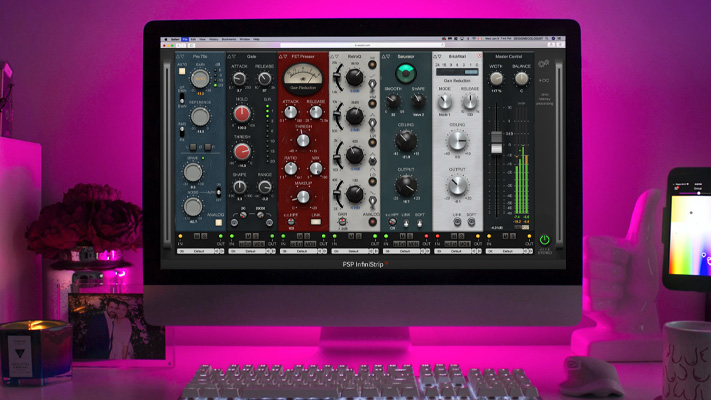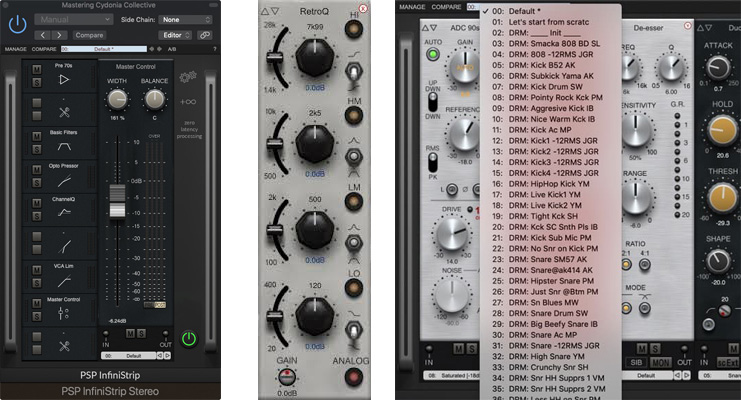PSP InfiniStrip
- Janurary 29, 2021.
- By Steve Castellano
- Product Intelligence Report
500 series modules have become the go-to format for engineers and producers looking to create their own built-to-order channel strip. With their compact modular format and wide range of available high-end components, their popularity is understandable. PSP is clearly inviting comparison with the PSP InfiniStrip, a virtual channel strip rack with space for up to nine modules from a total of 24 available processors . The InfiniStrip also promises zero latency – so expectations are high in terms of both sound quality and performance.
What’s in the box

InfiniStrip is a virtual rack with nine slots into which you can insert one of eight module types: preamps, filters, dynamic modules, compressors, equalizers, limiters, control, and a special category. With the exception of the Master Control module, each module type has between two and five types. Most of these are newly designed by PSP for the InfiniStrip, with five modules – FET Pressor compressor, PreQursor and RetroQ EQ modules, plus VCA and Opto Limiters – being adaptations of existing PSP plugins.
Seven of the nine slots are dedicated to a particular module type, from Preamp to Master. Any module can be assigned to either of the two remaining slots, and slots may be rearranged in any order. That’s a lot of mixing options in one plugin.
The InfiniStrip is extremely easy to use. Each module type has a consistent set of controls, with some variation. Each module within a type models a specific circuitry, often associated with a particular era, but the controls and their functions stay in the same place. Conveniently, so do their settings. Once you’ve got your EQ set the way you like it, for example, you can flip through the various models to see which one best suits the track, and continue to refine from there.
The interface
Contributing to the InfiniStrip’s ease of use is its user-friendly interface. Hints (tool tips) are detailed enough that even a novice could rely on them and skip the manual most days, though the manual is concise and informative as well. Most tasks are pretty intuitive – click and drag to re-order modules within a rack, click on a module name to see a menu of what other models are available, or use the arrows in the upper left corner to cycle through them.

Three rack view modes can be selected from the gears icon on the right side of the rack. Resizable view mode made most sense to me, shrinking the rack to show only the slots in use. You can also shrink to view one module at a time, or expand to the full 9-slot width. Being new to this style of plugin, I began to appreciate the tidiness and consistency of the 500-series style rack. I’m used to digging through numerous plugin windows of various sizes and shapes, trying to find one processor underneath all the rest.
I particularly like the tri-colour input and output LEDs in the bottom corners of each module. Proper gain staging is essential to a good mix, but it’s one of the least interesting chores to deal with. The InfiniStrip lets you see at a glance how hard your signal is hitting each module so you can adjust levels accordingly. This is particularly handy when you’re flipping through the 170-odd supplied presets.
Making some noise
Before I got into a full mix, I wanted to test out the zero latency claim on my electric piano. It has a bit of a hum to it (overdue for service, sadly), so I was glad to see the De-hummer in the special category. After trying out some presets and making some adjustments, I ended up with a Pre 60s (tube emulation) preamp, FET Pressor and RetroQ chain that gave me a nice bite. Then added in a Saturator module in the limiter slot, dialed in some valve saturation, and was quite pleased with the results.
I thought that after using the InfiniStrip for a while I might settle on a favourite lineup – a custom console strip that I would put on every channel – but after working through a couple of mixes I began to appreciate the variety and character of most of the processors, and found a use for almost all of them. The ChannelQ module, for example, felt clean and precise, while the RetroQ definitely had a vintage vibe to it. Similarly, the FET Pressor helped bring my Wurlitzer forward in the mix, while the Opto Pressor was noticeably mellower. The ADC 90s preamp, with its 12-bit analogue to digital converter emulation, brought just the right colour to some lower bitrate sources.
Conclusions
What I liked: The InfiniStrip offers you a wide range of options in a number of essential processor categories, from transparent utilities to faithful reproductions of classic technology. The sound quality is excellent, and the CPU load is light enough that I never had to think twice about dropping an instance into a channel that needed it.
What I’d like to see: I’m hard pressed to find fault with the InfiniStrip. Considering how helpful it is with gain staging, a Master Control option with analogue VU meters would be nice, but stereo might be a squeeze given the format. And speaking of a squeeze, I wouldn’t want the Preset Memo A/B interface to be any smaller. But that’s really looking for something to complain about.
Overall: The InfiniStrip delivers on its promises. Zero latency makes it particularly well-suited to live recording and broadcast, as well as solo producers who mix as they track, but it’s a powerful and versatile toolset for sculpting a mix in its own right. The ease of use should be an aid to novices, and the side chain and ducking options should be attractive to podcasters and videographers. The free 30-day trial makes it easy for you to decide for yourself. PSP InfiniStrip is currently available for $199 at pspaudioware.com
Author

Steve Castellano
Steve Castellano is a musician and writer living in Toronto, Canada. He holds a music degree from York University, where his focus was electronic music and composition. He currently records and performs modular electronic music under the name Elettronica Sperimentale.